| |
Peginterferon alfa-2b and weight-based or flat-dose ribavirin in chronic hepatitis C patients: A randomized trial
|
| |
| |
Hepatology Oct 2007
Ira M. Jacobson 1 *, Robert S. Brown Jr 2, Bradley Freilich 3, Nezam Afdhal 4, Paul Y. Kwo 5, John Santoro 6, Scott Becker 7, Adil E. Wakil 8, David Pound 9, Eliot Godofsky 10, Robert Strauss 11, David Bernstein 12, Steven Flamm 13, Mary Pat Pauly 14, Pabak Mukhopadhyay 15, Louis H. Griffel 15, Clifford A. Brass 15, WIN-R Study Group
1Weill Medical College of Cornell University, Center for the Study of Hepatitis C, New York Presbyterian Hospital, New York, NY
2Columbia University College of Physicians & Surgeons, New York Presbyterian Hospital, New York, NY
3Baptist Medical Center, Kansas City, MO
4Beth Israel Deaconess Medical Center, Boston, MA
5Indiana University School of Medicine, Indianapolis, IN
6Atlantic Gastroenterology Associates, Egg Harbor Township, NJ
7Austin Gastroenterology, PA, Austin, TX
8California Pacific Medical Center, San Francisco, CA
9Indianapolis Gastroenterology RSCH, Indianapolis, IN
10Bach and Godofsky, MD PA, Bradenton, FL
11Northwest Georgia Gastroenterology Associates, PC, Marietta, GA
12North Shore University Hospital, Manhasset, NY
13Northwestern University, Feinberg School of Medicine, Chicago, IL
14Kaiser Permanente, Sacramento, CA
15Schering-Plough Research Institute, Kenilworth, NJ
ABSTRACT
This prospective, multicenter, community-based and academic-based, open-label, investigator-initiated, U.S. study evaluated efficacy and safety of pegylated interferon (PEG-IFN) alfa-2b plus a flat or weight-based dose of ribavirin (RBV) in adults with chronic hepatitis C. Patients (n = 5027) were randomly assigned to receive PEG-IFN alfa-2b 1.5 ug/kg/week plus flat-dose (800 mg/day) or weight-based (800-1400 mg/day) RBV for 48 weeks (patients with genotype 1, 4, 5, or 6) and for 24 or 48 weeks (genotype 2/3 patients).
Primary end point was sustained virologic response (undetectable [<125 IU/mL] serum hepatitis C virus RNA at 24-week follow-up). Sustained virologic response, but not end-of-treatment, rates were significantly higher with weight-based than with flat-dose RBV (44.2% versus 40.5%; P = 0.008).
Sustained virologic response rates by intention-to-treat analysis were 34.0% and 28.9%, respectively, in genotype 1 patients (P = 0.005) and 31.2% and 26.7%, respectively, in genotype 1 patients with high baseline viral load (P = 0.056).
In genotype 2/3 patients, rates were not significantly different (61.8% and 59.5%, respectively) regardless of treatment duration.
Besides greater hemoglobin reductions with weight-based RBV, safety profiles were similar across RBV dosing groups, including the 1400-mg/day group.
"...Erythropoietin was permitted only if hemoglobin concentration decreased to less than 10 g/dL and if used concomitantly with the protocol-mandated RBV dose reduction. Reinstitution of the original RBV dose was permitted if the hemoglobin concentration increased to <11.5 ug/dL. In the case of neutropenia, PEG-IFN alfa-2b given at 1.5 ug/kg/week was reduced to 1.0 g/kg/week in patients who had an absolute neutrophil count (ANC) <750 cells/mm3, and PEG-IFN alfa-2b was discontinued in patients with an ANC <400 cells/mm3. Filgrastim was permitted for ANC <750/mm3with concomitant PEG-IFN alfa-2b dose reduction; initial PEG-IFN alfa-2b dose was reinstituted when the ANC was more than 1250/mm3...."
Conclusion: PEG-IFN alfa-2b plus weight-based RBV is more effective than flat-dose RBV, particularly in genotype 1 patients, providing equivalent efficacy across all weight groups. RBV 1400 mg/day is appropriate for patients 105 to 125 kg. For genotype 2/3 patients, 24 weeks of treatment with flat-dose RBV is adequate; no evidence of additional benefit of extending treatment to 48 weeks was demonstrated.
Article Text
Chronic hepatitis C is a leading cause of cirrhosis and hepatocellular carcinoma[1][2] and the leading indication for liver transplantation[3] in the United States. With pegylated interferon (PEG-IFN) and ribavirin (RBV) therapy, more than 50% of patients with compensated liver disease from hepatitis C virus (HCV) infection attain sustained virologic response (SVR).[4][5] Several factors influence treatment response, including baseline viral load and HCV genotype; optimizing drug dosing and treatment duration is essential to maximizing response.[6]
The pivotal trial establishing PEG-IFN alfa-2b and RBV efficacy showed that treatment for 48 weeks with PEG-IFN alfa-2b 1.5 ug/kg/week and a flat dose (FD) of ribavirin (800 mg/day) was statistically superior to IFN alfa-2b or a low-dose (0.5 g/kg/week) of PEG-IFN alfa-2b and a weight-based dose (WBD) of RBV (1000-1200 mg/d).[4] However, logistic regression analysis showed a strong linear relationship between RBV exposure (in milligrams per kilogram) and SVR in the FD RBV arm, suggesting that superior SVR rates up to 61% would be attainable if PEG-IFN alfa-2b 1.5 ug/kg/week were combined with a higher WBD of RBV than the 800-mg/day dose studied in the pivotal trial.[4]
To test the hypothesis that WBD RBV is more effective than FD, the Weight-Based Dosing of PegINterferon alfa-2b and Ribavirin (WIN-R) trial was conducted. The efficacy of 24 versus 48 weeks of therapy was also assessed in patients infected with HCV genotype 2 or 3 (G2/3), who are more responsive than those with G1 to IFN-based therapy.[7-9]
Patients and Methods
Patient SelectionL
Treatment-naive chronic hepatitis C patients, 18 to 70 years old, body weight less than 125 kg, with detectable serum HCV RNA determined by polymerase chain reaction (PCR) or branched DNA assay, were enrolled. Additional inclusion criteria included documentation of elevated alanine aminotransferase level within the 6 months before entry; liver biopsy specimen consistent with chronic hepatitis C (read by the local pathologist) within the 36 months before entry; compensated liver disease; and a-fetoprotein level of <100 ng/mL in the year preceding entry. Major exclusion criteria included a positive test result for hepatitis B surface antigen or human immunodeficiency virus infection.
Study Design and Conduct
This prospective, multicenter, open-label, investigator-initiated, community-based and academic-based study was conducted at 236 sites in the United States. Patients were randomly assigned 1:1 to receive PEG-IFN alfa-2b 1.5 Ug/kg/week plus daily RBV (administered subcutaneously and orally) as either (1) an FD of 800 mg/day or (2) a WBD of 800 mg for patients weighing <65 kg; 1000 mg for patients weighing 65 to 85 kg; 1200 mg for patients weighing > 85 to 105 kg; and 1400 mg for patients weighing >105 kg but <125 kg (Fig. 1). Central randomization was implemented using a block size of 10; sequence was concealed until treatment was allocated. Computer-generated randomization codes were generated by a central statistician (Schering-Plough Research Institute [SPRI]) and assigned by a third-party database manager (Therapeias Health Management Inc., Claremont, CA). Groups were stratified by HCV genotype (G2/3 versus G1, G4, G5, or G6) and by fibrosis score (METAVIR score F0-F2 versus F3-F4). All patients were followed up for 24 weeks after treatment. Initially, all patients were to be treated for 48 weeks. Shortly after the study began, the protocol was amended to offer random allocation to 24 or 48 weeks of therapy for G2/3 patients. To ensure an adequate number of G2/3 patients, enrollment for these patients was extended for 14 months after sites were instructed to close G1 enrollment, which resulted in a higher proportion of G2/3 patients than found in the general population.
Guidelines for discontinuing, interrupting, or lowering the dose of study medication for adverse events and hematologic or biochemical abnormalities were specified in the protocol. RBV doses were reduced if hemoglobin level reached < 10 g/dL; treatment was discontinued if hemoglobin level was < 8.5 g/dL. Two-step reductions of RBV dose were allowed. The initial dosage reduction was 200 mg/day for all subjects except those taking the 1400-mg/day dosage, for which the initial reduction was 400 mg/day. The second dose reduction was an additional 200 mg/day. Erythropoietin was permitted only if hemoglobin concentration decreased to less than 10 g/dL and if used concomitantly with the protocol-mandated RBV dose reduction. Reinstitution of the original RBV dose was permitted if the hemoglobin concentration increased to <11.5 g/dL. In the case of neutropenia, PEG-IFN alfa-2b given at 1.5 ug/kg/week was reduced to 1.0 ug/kg/week in patients who had an absolute neutrophil count (ANC) <750 cells/mm3, and PEG-IFN alfa-2b was discontinued in patients with an ANC <400 cells/mm3. Filgrastim was permitted for ANC <750/mm3with concomitant PEG-IFN alfa-2b dose reduction; initial PEG-IFN alfa-2b dose was reinstituted when the ANC was more than 1250/mm3. The study was approved by the Ethics Committees at all participating institutions and conducted according to the recommendations of Good Clinical Practice and the Declaration of Helsinki. All patients gave written informed consent to participate in the study.
Assessment and End Points
HCV RNA was measured at weeks 24 and 48 of treatment and 24 weeks after treatment. Most HCV RNA analyses (TaqMan; Applied Biosystems, Foster City, CA; lower limit of detection of 125 IU/mL [430 copies/mL]) were performed centrally at the SPRI; when specimens were not sent to the central laboratory, analyses performed at local laboratories were accepted. A subset of the samples tested at the SPRI laboratory was sent for confirmatory testing to Quest Nichols Laboratory (San Juan Capistrano, CA). The primary objective of the study was to evaluate the safety and efficacy of PEG-IFN alfa-2b in combination with 2 different RBV regimens for the treatment of chronic hepatitis C. Per protocol, the primary efficacy end point was SVR: undetectable serum HCV RNA 24 weeks after treatment. The primary efficacy analysis was restricted to patients weighing >65 kg at baseline because all patients weighing <65 kg received RBV 800 mg/day, regardless of group assignment. The secondary efficacy end point was the difference in SVR rates among G2/3 patients treated for 24 or 48 weeks. Safety was monitored by clinical and laboratory evaluations; adverse events were recorded.
In addition to SVR rates, other assessments were made during the trial. Relapse rates for each treatment group were calculated, based on those patients with undetectable HCV RNA at the end of treatment and available 24-week follow-up HCV RNA PCR results, as the percentage of these patients who were HCV RNA positive at follow-up. To assess erythropoietin use, investigators were asked to complete and return a form if erythropoietin was used during the study. Investigators were not asked to record the timing or duration of use. Compliance was measured using drug start and stop dates as reported by the investigators.
Statistical Analysis
Screening was planned for 3500 patients; 2933 patients were expected to enroll and be randomly assigned 1:1 to the 2 regimens for 48 weeks. A protocol amendment modified the number of screened and enrolled patients to 5000 and 4000 to ensure adequate random allocation of G2/3 patients to receive 24 or 48 weeks of treatment. Random allocation of G2/3 patients was initially 4:3 to offset the number of patients who passed the 24-week period by the time of amendment and was subsequently adjusted to 3:1 for the same reason. With 2000 patients each in the WBD and FD groups, the study had 80% power to detect a 5.5% difference in the SVR rate between these 2 treatment groups. With more than 4000 patients randomized, the study was adequately powered to have enough G2/3 patients to establish the noninferiority (with a noninferiority margin of 7%) of 24 weeks of treatment compared with 48 weeks of treatment among these patients. The study was not designed or powered to demonstrate a difference in the SVR rates between WBD and FD groups among G2/3 patients.
The number and proportion of SVRs, along with corresponding approximate 95% confidence intervals (CI), were summarized for each of the 2 treatment groups. A logistic regression model, which included effects due to treatment and baseline stratification factors (F0/1/2 versus F3/4 and G2/3 versus G1, G4, G5, G6), was used to compare the 2 groups. A 95% CI for the difference in SVRs between the 2 treatment groups (adjusted for the baseline stratification factors) was also computed. The Pearson chi-squared test was used to compare the SVRs in some subgroups.
Three sensitivity analyses were performed: (1) All patients: including those weighing < 65 kg; (2) estimated SVR: intended to account for patients with undetectable HCV RNA at end of treatment and who lacked follow-up data and were considered nonresponders in the primary analysis (To determine estimated SVR rate, relapse rates based on rates of patients with available data were imputed to those lost to follow-up.); (3) completers: patients who completed the assigned course of therapy (regardless of whether dose reductions were implemented for PEG-IFN alfa-2b, RBV, or both) and for whom end-of-treatment data were available.
The relative efficacy of 24 versus 48 weeks of treatment for G2/3 patients was assessed by 95% CI, adjusted for treatment group and baseline stratification factors. The 2-sided 95% CI for the difference in SVR between the 2 durations was computed using normal approximation to the binomial and controlling for WBD/FD treatment group, genotype (G2 versus G3), and presence/absence of fibrosis/cirrhosis. Therapy for 24 weeks was to be declared noninferior to 48 weeks if the adjusted 95% CI for the difference in SVR rates between the 2 groups excluded 7%.
Results
Patient Characteristics
A total of 5027 of 5519 patients enrolled between January 2000 and March 2003 received at least 1 dose of drug (Fig. 1). Of these, 114 patients were excluded from analysis because of lack of source documentation at the study sites; therefore, the primary safety population (all treated patients) consisted of 4913 patients; 4223 patients (86.0%) weighing .65 kg made up the primary efficacy population. Baseline host and viral characteristics were similar between the 2 groups (Table 1). Mean weight was 84 kg, with the following weight distribution: <65 kg: 14%; 65 to 85 kg: 41%; >85 kg to 105 kg: 34%; and >105 kg: 11%. Discontinuation occurred in 36.8% of the primary safety population (Fig. 1).
End-of-Treatment Response Rates: All Genotypes
Overall, end-of-treatment responses were attained by 59.2% and 56.8% (P = 0.082) of patients in the WBD and FD RBV groups, respectively; by 49.0% and 45.6% (P = 0.077) of G1 patients; and by 77.2% and 75.2% (P = 0.355) of G2/3 patients.
Primary Efficacy Analysis: All Genotypes
SVR was achieved by significantly more patients who received WBD (44.2%) than FD (40.5%; P = 0.008) RBV (Table 2). This was also true for all G1 patients (34.0% versus 28.9%; P = 0.005) and for G1 African American patients (20.7% versus 10.1%; P = 0.006). Patients with G1 and high baseline viral loads (>600,000 IU/mL) had a higher SVR rate with WBD than with FD (31.2% versus 26.7%, respectively); however, this difference did not reach statistical significance (P = 0.056). Overall, response rates decreased as weight increased when FD RBV was used (P = 0.001) but remained unaltered with WBD RBV (P = 0.973; Fig. 2) based on the Mantel-Haenszel chi-square test for comparing ordinal categories. A similar relationship occurred in the G1 population (P = 0.019 FD, P = 0.569 WBD), as well as in the G2/3 population (P = 0.034 FD, P = 0.356 WBD). In G1 African American patients, the SVR rate improved with increasing weight in the WBD group (P = 0.036) and was not statistically different in the FD group (P = 0.446), but this was likely because of its small sample size (see companion article in this issue).
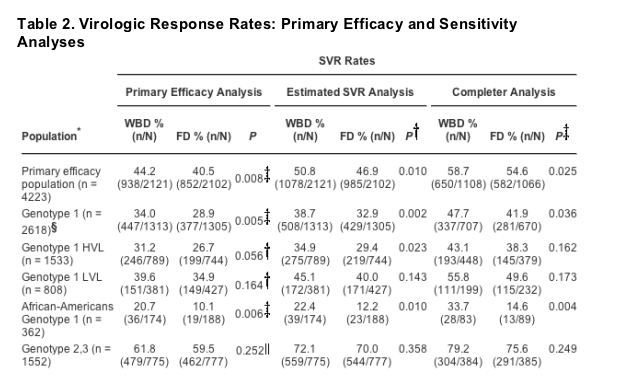
Primary efficacy analysis included all patients >65 kg. Estimated SVR analysis data was obtained by imputing rates of relapse from patients with complete data to those with missing follow-up PCR results. The completer analysis included patients who completed their assigned course of therapy and for whom end-of-treatment data were available. Abbreviations: FD, flat dose; HVL, high viral load; LVL, low viral load; SVR, sustained virologic response; WBD, weight-based dose.
* Total number applies to the primary efficacy and estimated SVR analyses only.
P value is based on the chi-squared test.
P value is based on the logistic regression of SVR, with treatment, fibrosis, and genotype included in the model.
�� For HVL and LVL data, 277 patients did not have a numerical baseline value.
P value is based on a logistic regression model that includes the effect of treatment (WBD versus FD), presence of advanced fibrosis/cirrhosis, genotype (2 versus 3), and duration (24 versus 48 weeks).
Figure 2. Sustained virologic response (SVR) rates by weight distribution in subpopulations of patients receiving weight-based dose (WBD) or flat-dose (FD) ribavirin. P values are based on the Mantel-Haenszel chi-squared test for comparing ordinal categories.

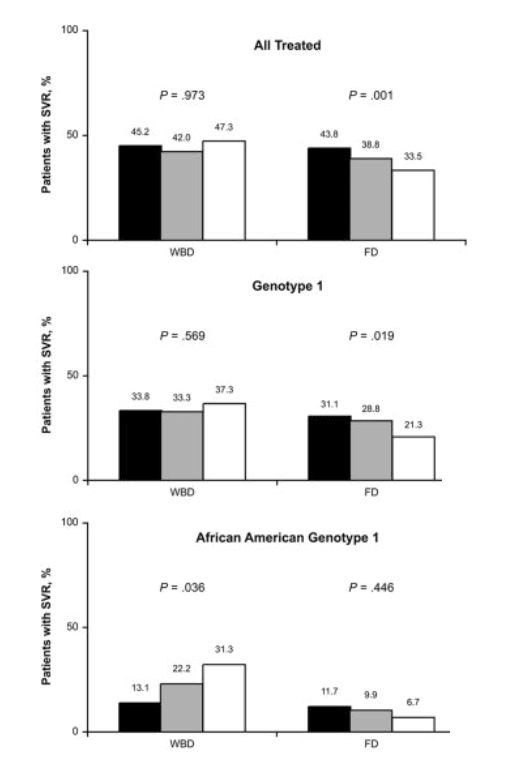
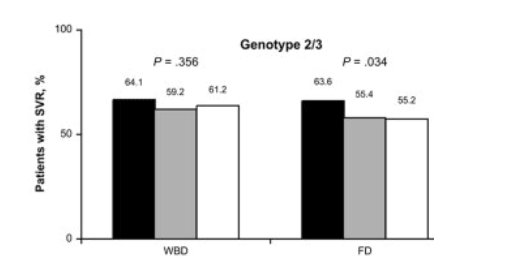
Overall, relapse rates were 15.3% with WBD RBV and 19.0% with FD RBV and were highest for patients with G1 (WBD: 23.0%; FD: 29.6%) and lowest for those with G2 (WBD: 4.2%; FD: 5.9%) or G3 (WBD: 10.6%; FD: 12.0%; Table 3).
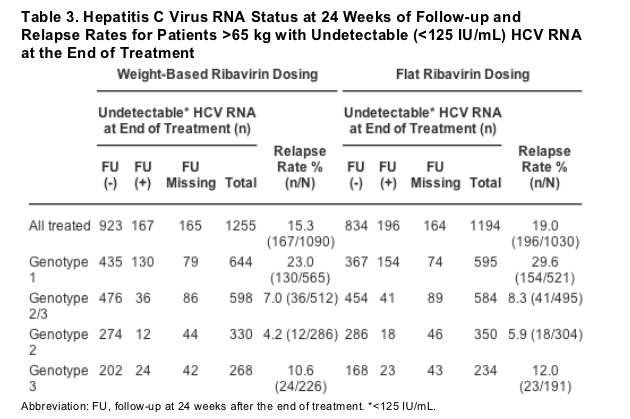
Analysis of Patients with HCV G2 or G3
Compared with 24 weeks of treatment (SVR rate, 66.2%), 48 weeks of treatment (SVR rate: 58.6%) provided no additional benefit. Although 24 weeks of treatment fulfilled the criteria for noninferiority, more patients in the 48-week group (26% versus 33%) lacked follow-up data and were considered nonresponders in the intention-to-treat analysis. Among G2/3 patients randomly assigned to 24 weeks of treatment, SVR rates were 67.7% with WBD and 65.0% with FD RBV (P = 0.560). In the primary efficacy analysis (including patients treated for 24 or 48 weeks), WBD RBV resulted in an SVR rate of 61.8% among patients with G2/3, compared with 59.5% for FD (P = 0.252; Table 2), and responses were consistent across all weight categories in the WBD group (P = 0.356), but decreased with increasing weight in the FD group (P = 0.034; Fig. 2).
Sensitivity Analyses
All-Patient Analysis.
Consistent with the primary efficacy analysis (n = 4223), inclusion of subjects weighing < 65 kg (n = 690; total population, n = 4913) yielded higher SVR rates with WBD (45.0%) than with FD RBV (41.9%; P = 0.021).
Estimated SVR Analysis.
In the primary efficacy analysis, 329 patients (165 WBD; 164 FD) had undetectable HCV RNA at the end of treatment but had missing follow-up PCR results and were considered nonresponders. Of the 329 patients, 153 were G1 (79 in the WBD group and 74 in the FD group), and 175 were G2/3 (86 in the WBD group and 89 in the FD group); 1 patient was G4. Estimated SVR rates, obtained by imputing rates of relapse from patients with complete data to those with missing follow-up PCR results, were higher for the WBD group (50.8%) than for the FD group (46.9%; P = 0.01; Table 2). WBD RBV showed significant superiority for the G1 subgroup (38.7% versus 32.9%; P = 0.002). For G2/3 patients, estimated SVR rates did not differ significantly between groups (72.1% for the WBD group and 70.0% for the FD group).
Completer Analysis.
When all patients with available end-of-treatment data who completed their assigned course of therapy were analyzed, WBD showed significantly superior SVR rates (58.7%) to FD RBV rates (54.6%; P = 0.025; Table 2). SVR rates for G1 patients, G1 patients with high viral load, and G2/3 patients were 47.7% and 41.9% (P = 0.036), 43.1% and 38.3%, and 79.2% and 75.6%, respectively.
Predictors of Response.
RBV dosing was a significant, independent predictor of virologic response. Univariate analyses identified genotype, race, cirrhosis, and baseline viral load as significant predictors of SVR in each treatment group (data not shown). Additional predictors in the FD group were baseline weight, fibrosis, and sex, with the gender effect attributable to most of the lighter patients being female. In the multivariate regression analysis, significant prognosticators of a response after adjustment for factors identified by univariate analysis were RBV dosing (WBD versus FD; odds ratio [OR] = 1.20; CI, 1.050-1.362; P = 0.0069), baseline viral load (OR = 0.77; CI, 0.711-0.838; P < 0.0001), genotype (other versus 1; OR = 2.286; CI, 0.673-7.762; P < 0.0001), cirrhosis (cirrhosis versus no cirrhosis; OR = 0.584; CI, 0.470-0.727; P < 0.0001), and race [Caucasian, Asian, Latino, other, versus African American; OR = 2.41-3.70 (range); P < 0.0001 for all comparisons].
Safety
Adverse events (most were mild to moderate and typical of those previously reported for PEG-IFN alfa-2b/RBV therapy[4]) were reported by 95% (4677/4913) of patients (Table 4). The most frequent adverse events included fatigue, headache, depression, insomnia, nausea, myalgia, anemia, fever, neutropenia, arthralgia, and irritability. With the exception of anemia, occurrence of adverse events was similar between the 2 treatment groups and among the different RBV dose groups, including the 1400-mg group.
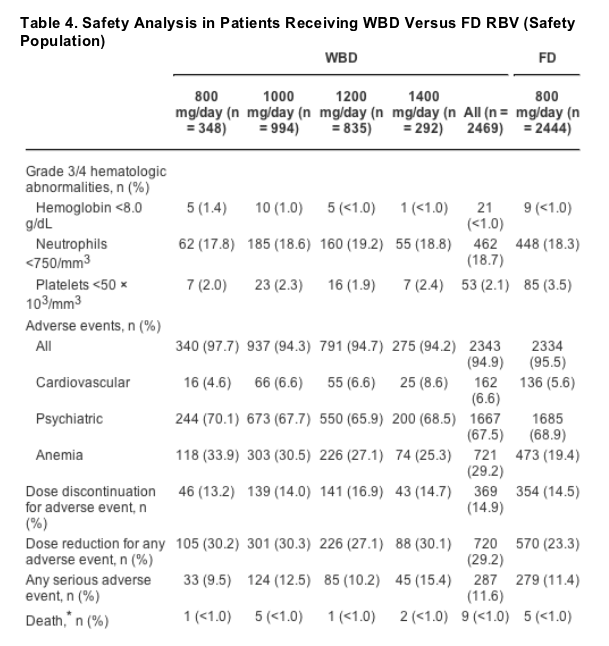
*Five deaths were classified by the local investigator or project physician as possibly (n = 4) or probably (n = 1) related to treatment (2 in the 1000-mg/day subgroup, 1 in the 1200-mg/day subgroup, and 2 in the FD group). Abbreviations: FD, flat dose; WBD, weight-based dose.
Overall frequency of serious adverse events was comparable in the WBD (11.6%) and FD (11.4%) groups. There was no dose relationship with serious adverse events in the WBD subgroups. Psychiatric disorders were the most frequently reported serious adverse events (2.9%). Dose modifications overall were 29.2% and 23.3% and for each group were as follows: PEG-IFN alfa-2b, 5.6% versus 7.3%; RBV, 11.2% versus 7.4%; both, 12.4% versus 8.5%. Depression and fatigue were the most frequent reasons for discontinuing therapy because of an adverse event, and rates of dose discontinuation because of adverse events were similar in both groups (14.9% and 14.5%). Five of 14 deaths during the study were classified by the local investigator or project physician as probably (n = 1) or possibly (n = 4) related to treatment: 2 in the 1000-mg/day subgroup, 1 in the 1200-mg/day subgroup, and 2 in the FD group (Table 4). One patient, who had a history of cervical cancer, had sepsis with pulmonary infiltrates and a lung mass in her sixth month of therapy; this patient was not neutropenic 2 weeks before the final admission. A second patient, who had a history of depression and cocaine use, died after admission for a syncopal episode after 4 months of therapy. A third patient, who had a history of attempted suicide, was found dead in a hotel room 1 day after release from a psychiatric unit after a domestic abuse incident. A fourth patient, in his 10th month of treatment, died after consumption of ethanol and Lysol. A fifth patient, who had a history of hypertension, anxiety, and depression, died in her sleep during the second month of treatment.
Significant anemia (that is, hemoglobin concentration <10 g/dL) occurred more frequently in the WBD group than in the FD group (19.3% versus 12.5%). However, only 1% of patients discontinued treatment because of anemia. Mean hemoglobin concentrations were 0.5 g/dL lower throughout treatment in the WBD group than in the FD group, but mean hemoglobin concentration decreases for all ribavirin doses in the WBD group, including the 1400-mg dose, were similar. Erythropoietin use was reported for 9% of the WBD and 5% of the FD group; these figures reflect those for whom the appropriate questionnaires were returned. Grade 3/4 neutropenia occurred with similar frequency in both groups, as did grade 3/4 thrombocytopenia.
DISCUSSION
This large, "real-world", U.S. trial affirms the finding of the secondary analysis from the PEG-IFN alfa-2b/RBV pivotal trial[4] that efficacy of WBD RBV combined with PEG-IFN alfa-2b 1.5 ug/kg/week is superior to that of FD 800 mg/day of RBV. For the WBD group, SVR rates were higher than those for the FD group and were similar across all body weights; for the FD group, SVR rates progressively decreased as body weight increased. The superiority of WBD RBV was noted in patients with G1, the genotype most prevalent and most refractory to IFN-based antiviral therapy. This observation is consistent with a prior international report in which treatment with PEG-IFN alfa-2a 180 g/wk with RBV 800 mg/day or 1000 to 1200 mg/day for 48 weeks was evaluated.[10] This study, however, did not evaluate efficacy across different body weights. Another large international trial with PEG-IFN alfa-2a 180 g/week plus RBV 1000 to 1200 mg/day for 48 weeks found that, by multivariable analyses, a body weight of <75 kg independently and significantly increased the odds of attaining SVR.[5] In contrast, in our study, WBD RBV at a dose of 800 to 1400 mg removed body weight as a factor that influenced response in the more difficult-to-treat G1 patients when combined with PEG-IFN alfa-2b 1.5 ug/kg/week.
In the current study, 48 weeks of therapy offered no apparent advantage over 24 weeks for patients with G2/3; WBD RBV, although achieving a numerically higher SVR (61.8% versus 59.5%), offered no overall statistical advantage over FD RBV. The trend toward lower efficacy of FD RBV in heavier patients (Fig. 2) may not have been sufficient to affect the results in the overall cohort because of sample size, but this issue warrants further evaluation in other studies. The current study, with its larger patient population and identical PEG-IFN doses in both treatment arms, establishes more firmly the conclusions about the equivalence of 24 and 48 weeks of treatment in patients with G2 and G3 reached by Hadziyannis et al.[10] in their study of PEG-IFN alfa-2a. However, neither our study nor the previous study using PEG-IFN alfa-2a addresses the issue of whether the ability to truncate therapy to less than 24 weeks based on viral clearance by week 4, a possibility raised by several recent studies,[11-13] depends on initial RBV dose. Similarly, caution should be exercised in drawing definitive conclusions about duration of therapy in selected subgroups of patients with G2/3 such as patients with advanced fibrosis or those with slow therapeutic response.
From a safety standpoint, weight-based dosing of RBV is appropriate. The 14.7% of patients who discontinued because of adverse events is comparable to the 14.0% of PEG-IFN alfa-2b and RBV patients in the PEG-IFN alfa-2b/RBV pivotal trial who discontinued,[4] and the rates of discontinuation and serious adverse events were equivalent between the WBD and FD groups. Furthermore, by using drug start and stop dates provided by the investigators, treatment compliance was greater than 80% of expected duration for approximately two thirds of patients in the trial. These observations are important given that previous studies have shown that patients who are compliant with 80% of their IFN and RBV doses for 80% of the treatment duration have enhanced virologic response.[6] Mean hemoglobin levels decreased to a lesser extent in the FD than in the WBD groups, which is consistent with the dose-related capacity of RBV to induce hemolytic anemia; a greater number of dose reductions of RBV was seen with WBD. Among patients in the WBD group, no increase in anemia was seen with increasing RBV dose; most notably, in patients receiving the 1400-mg/day RBV dosage, the degree of hemoglobin decrease was similar to that of lighter patients who received less RBV. The reported rates of erythropoietin use were low but greater in the WBD arm than in the FD arm. This greater frequency may have slightly attenuated the difference in mean hemoglobin levels between treatment arms. However, the protocol was designed to prevent erythropoietin use from serving as an alternative to dose reductions, minimizing the potential effect of erythropoietin use on the conclusions about safety and efficacy of WBD RBV. Coupling this safety profile with the similar rates of SVR across all body weights with the 800-mg to 1400-mg RBV dosing, WBD RBV should be an effective treatment strategy, and a 1400-mg/day dosage of RBV should be used in patients who weigh >105 kg.
The current trial is distinctive because it was restricted to U.S. patients. Evidence indicates that SVR rates among U.S. patients are lower than among patients from other countries, particularly patients with G1.[14-16] For example, in the pivotal trial,[4] 37% of U.S. patients with G1 receiving PEG-IFN alfa-2b 1.5 ug/kg/week plus RBV 800 mg/day attained SVR, compared with 52% of non-U.S. patients, who made up 30% of the study population (Schering-Plough Research Institute, data on file). Additionally, 31% to 39% of U.S. patients with HCV G1 receiving PEG-IFN alfa-2a 180 ug/day plus RBV 1000 to 1200 mg/day achieved SVR, compared with 54% to 58% of non-U.S. G1 patients.[15] The difference in responsiveness to IFN-based therapy between U.S. and non-U.S. patients may be attributed to differences in body weight: U.S. patients are heavier on average than non-U.S. patients. The potential role of other mechanisms in producing geographic differences in response, even when corrected for genotype, must be determined.
SVR rates presented herein must be interpreted in the context of the study design. The uniquely broad spectrum of academic and community sites (with the latter predominating) and the fact that PEG-IFN alfa-2b became available to the public during the course of this trial may account for the number of patients lost to follow-up, including the 329 patients who were responders at end of treatment with missing follow-up PCR data who were counted as nonresponders in the intent-to-treat analysis and the 150 patients who discontinued before the 12-week point for reasons unrelated to adverse events. Such discontinuations are less common in registration trials[4][5] and were probably related to individual issues at sites or to the inclusion of a broader spectrum of patients than seen with registration trials.
The WIN-R trial shows both the power and the limitations of investigator-initiated trials to evaluate therapeutic issues for which very large populations are necessary. This trial confirmed that WBD RBV is superior to FD RBV for patients with HCV G1; established the efficacy and safety of a new dosage of 1400 mg/day for patients who weigh > 105 kg; demonstrated equivalent rates of SVR across a spectrum of body weights with WBD dosing of RBV and PEG-IFN alfa-2b; and showed, in a larger study population than hitherto reported, equivalent SVR rates between 24 and 48 weeks of treatment for patients with HCV G2 and G3.
|
|
| |
| |
|
|
|